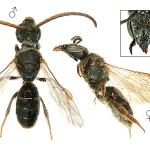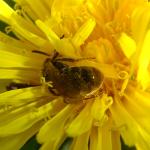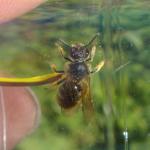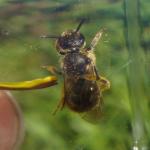Lasioglossum freygessneri ALFKEN 1904
Widespread throughout the British Isles. Also known from the Channel Islands. A Eurasian species, found to the far east of Russia. In southern Europe it is mainly montane.
This species is not regarded as being scarce or threatened.
Mainly a species of moor and sandy heath, possibly preferring wooded parts.
Univoltine. Females fly from early April to September, with males from late June to September.
A mining bee with primitively eusocial colonies. The females have a long life span, up to a year, and a daughter will often remain with the foundress in the maternal nest. The latter then has more developed ovaries and usually guards the nest entrance, whilst the daughter carries out most of the foraging. The nest is illustrated by Heide (1992) and comprises an earth cell cluster held within a chamber by pillars. In a nest with only one female, there are up to nine cells, whilst a polygynous nest may have 17 (Pesenko et al. 2000). To provision one cell the female may make 10-13 foraging trips, the final few being for nectar only. Provisioning a cell may take two days.
These include bellflowers (Campanulaceae), bilberries (Vacciniuim myrtillus), daisies (Bellis perennis) and rosebay willowherb (Chamerion angustifolium).
L. fratellum is a host of the cleptoparasitic halictine Sphecodes hyalinatus.
2006





